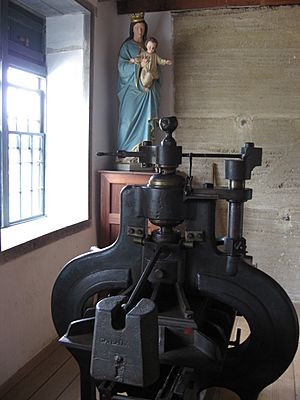Pompallier House facts for kids
Pompallier House is a very old building in Russell, New Zealand. It was built in the 1800s and used to be the main office for a French Catholic mission. This mission worked in the Western Pacific region. The house is named after Jean Baptiste Pompallier. He was the first Catholic leader to visit New Zealand. He started many missions across the North Island.
Today, Heritage New Zealand looks after Pompallier House. They open it for people to visit. It is special because it's New Zealand's oldest Catholic building. It's also the oldest building made from rammed earth. This means its walls were built by pressing layers of soil together. It's also considered New Zealand's oldest industrial building.
Contents
History of Pompallier House
How Pompallier House Was Built
In 1836, a group called the Society of Mary (or Marists) got permission from the Pope. Their job was to start missions in Western Oceania. Bishop Jean Baptiste Pompallier was part of this group.
In 1838, Bishop Pompallier and three brothers arrived in Hokianga, New Zealand. They began their work there. Later, more members joined them. They moved to the Bay of Islands to set up their main office. This office was in Kororareka, which is now called Russell.
Bishop Pompallier bought land in Russell in 1839. The Pompallier House building was constructed in 1841 and 1842. By 1842, the house was used to print books. It produced some of the first Māori translations of religious texts.
The missionaries did not have much money for timber. So, they used a building method called rammed earth. This was common in Lyon, France, where they came from. They dug earth from the building site. They added sand and rocks from nearby beaches. They even made lime by burning shells. The top floor was built with earth supported by wooden frames. An architect named Louis Perret oversaw the building work.
There were other buildings on the site too. These included a chapel, houses, and kitchens. But Pompallier House is the only one that remains today.
The Printing Press at Pompallier House
The original Gaveaux printing press came from France. It arrived at the mission in the early 1840s. Between 1842 and 1849, this press printed over 30,000 books and pamphlets. Many of these were the first books ever printed in the Māori language.
When the mission left Russell in 1850, the press was moved. In 1857, the Waikato Māori people asked for the press. Bishop Pompallier gave it to them. The press was then used by Tāwhiao, the Māori King. He used it to print a Māori-language newspaper called Te Paki o Matariki.
The press stayed in Waikato until the 1990s. Then, the Māori Queen Te Atairangikaahu returned it to Pompallier House. The building was originally built for printing. It also had a tannery to prepare leather for book-binding.
What Happened to the Mission Later
In 1850, the mission's main office moved to Auckland. In 1856, a man named James Callaghan took over the building. He changed it into a home and called it "Callaghan's Castle." The house was owned by several private people over the years. They made changes to the original building.
In 1941, the Government bought the building. In the 1990s, Pompallier House was fully restored. It was made to look just like it did when it was first built. The original printing press is still there. It has been fixed and can work again. The gardens around the house are also kept in the style of the Victorian and Edwardian times. These were popular garden styles when later owners lived there.
Visiting Pompallier House Today
You can visit Pompallier House every day of the week. To go inside the building, you need to join a guided tour. These tours happen four times a day. You can also buy tickets just to visit the gardens. The gardens are in the Victorian and Edwardian styles. There is also a hillside parkland walk. From here, you can see great views over the bay. A French Coffee House is also on site and is open daily.


